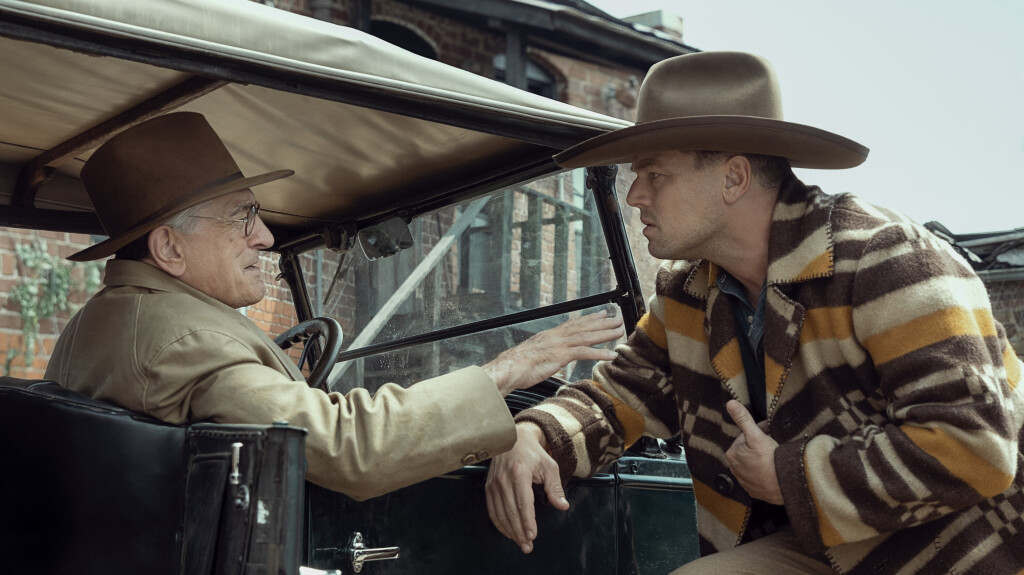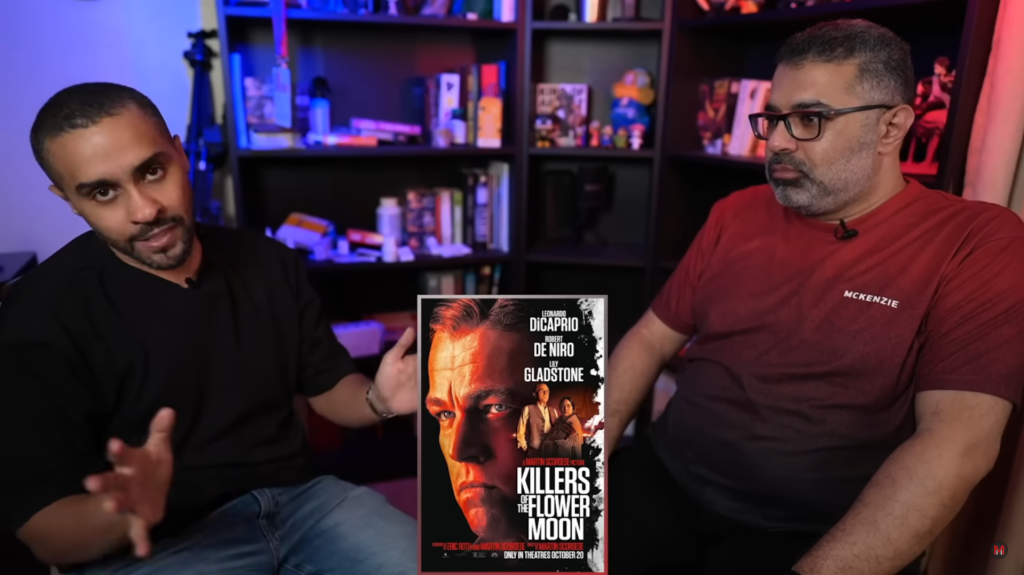Three names, if present in any film, are enough to draw attention to it and make it one of the most anticipated films in the year of its release. The great director Martin Scorsese, with his impressive record, remains at the highest levels of activity in filmmaking and accepting challenges even in his 80’s. Academy award winner and super star Leonardo Di Caprio. And the veteran star Robert De Niro, whose choices in recent years cannot be described as good, but his name will always remain synonymous with the expression “actor” in the minds of many, and when this name is associated with a great director and a bright star, he certainly adds a lot to the project…and the project is Killers of the Flower Moon.

De Niro and DiCaprio star in Martin Scorsese’s historical drama
Killers of the Flower Moon takes place in the early 1920s and is a true story documented in a book of the same title by David Grann. Our events begin with an explanation of the historical background of the characters of our story, who are the Osage community, the indigenous people of the American continent. After a long historical suffering, they were displaced to a barren land in the state of Oklahoma, but ironically, oil was discovered in that land and the members of that community became the richest people in the world. And with this extreme wealth come the envious eyes of the white man. Many infiltrate the peaceful community and begin a two-stage scheme. The first is creating family connections with the wealthy landowners by marrying their daughters, and the second is killing them in order to seize their wealth by inheritance.
The center of our story is Ernest Bukhart, who travels to join his uncle, William King Hale, in the land of the Osage. He also joins the white man’s plan against the wealthy people of the city. He quickly begins to woo Mollie, who has great wealth, and actually succeeds in marrying her while obeying all of his uncle’s instructions until he reaches the second stage of the plan.. Will he keep going forward to kill his wife? And will all these crimes go unpunished?
Our film is a historical epic that is very accurate in conveying what was stated in Grann’s book, with a great focus on the dramatic treatment of the social fabric of the heroes of our story, who are members of the Osage tribe and the greedy and criminal intruders who rise within the events to become its center and the key perspective. We see, in a very creative documentarian technique, how this society was formed, how it reached that level of damned wealth, and the resulting outcome that contradicts the stereotypical appearance of members of an outcast society, some of which reach the level of comedy.

Discussing Killers of the Flower Moon with Maher
Then we move on to the bulk of the film’s events, which lasts for 3 hours and twenty minutes, to enter the home of Mollie’s family and her sisters, who are the main target for William Hale and his minions, and we watch how the chapters of the satanic plan are carried out over the years. It is fascinating to watch Scorsese deal with these historical events and convey them through the human qualities, natures, and decisions of a tangible stage of events and a courtroom for the trial of each character. Under the hand of any other filmmaker, Mollie and her family would turn into fleeting images covered in the dust of history, and the focus shifts to the aspects of the crime: how it occurred, how far it went, and how it was confronted. Problem is .. I can’t decide which one I prefer!
Returning to the book from which the events of the film are based, its full title is Killers of the Flower Moon: The Osage Murders and the Birth of the FBI. It is clear from the title of the book that it balances the importance of historical events of the horror of the crimes committed with the most important outcome that resulted from them, which is the establishment of the Federal Bureau of Investigation. When the film was initially announced, Di Caprio was slated to play Tom White, an FBI agent who arrives to investigate the crimes. However, during the development stages, there was an exchange of roles, and the role of White was assigned to the wonderful actor Jesse Plemons, while Di Caprio chose the role of Bukhart. This was followed by major changes in Eric Roth’s script to make Bukhart the center of events and his perspective they key one for most of them.
The change came to bring the film closer to the Scorsese school, which is always interested in showcasing the corruption of society and studying the process of crime development from serious and humorous angles to the point of arousing admiration in many films. While a short section at the end of such films as The Wolf of Wall Street, Goodfellas, or Casino is devoted to the fall and legal accountability. Which is certainly what the screenplay for Killers of the Flower Moon ended up being.
I never like to rate any movie according to what it should have been in my personal opinion. But in this case, the change is public and, with all my regret, I find myself inclined towards it. The criminals and corrupt people in Scorsese’s films mentioned above were very attractive characters. Overwhelming presence, dazzling intelligence, and exceptional capabilities led to their rapid rise through the ranks of their society until their resounding fall. Our main criminal in the events of Killers of the Flower Moon is not. Ernest Buckhart is a pale character. He does not have any glow or presence, and his stock of moral codes does not allow for creating a conflict with his uncle’s evil intentions, and nothing stands in the way of implementing them at best except his apparent stupidity. Di Caprio’s portrayal of the character is perfect, but I don’t think it was a great investment spending the duration of the movie with him. Many of his scenes were redundant, and the only thing that raised their importance in my personal estimation was the dynamism and attractiveness accompanying the appearance of the King Hill character, especially with the portrayal of De Niro in what I consider to be his best appearance since Heat in 1995, and I mean it.
In this case, I find myself forced to agree that the duration of the film is too long. I reaffirm that studying juvenile society and respecting its historical and geographical dimensions is a cinematic achievement that brought us back to the golden times of cinema and can’t be compared to anything we have seen recently, not even from Scorsese himself. But I believe that the platform he built promised more and better in terms of rhythm and intensity of events, as it seemed to us for a long time that we were facing a systematic and widespread violation that can only be stopped by a miracle, and after it had gone on for more than I could bear, I almost wished that this miracle would never happen because this means that the events will continue for a longer period of time, which personally made me feel ashamed because I never thought I would make this confession in front of a Scorsese film.
In the end, I have to admit that it’s very difficult to answer the easiest of questions, which I always receive after watching any movie; Is Killers of the Flower Moon worth watching at the cinema? The first hour of events is definitely worth watching and enjoying in front of the largest screen possible. It is the richest visually and the most active in terms of rhythm. The rest of the film bears the stamps of dramatic creativity that are perfectly suitable for viewing at home with the film available on Apple TV+ platform. I think the most appropriate rating for the film is 8 out of 10, but this rating is not enough to express my frustration at its wasted opportunities. So I’m well settled at 7.5 out of 10.

